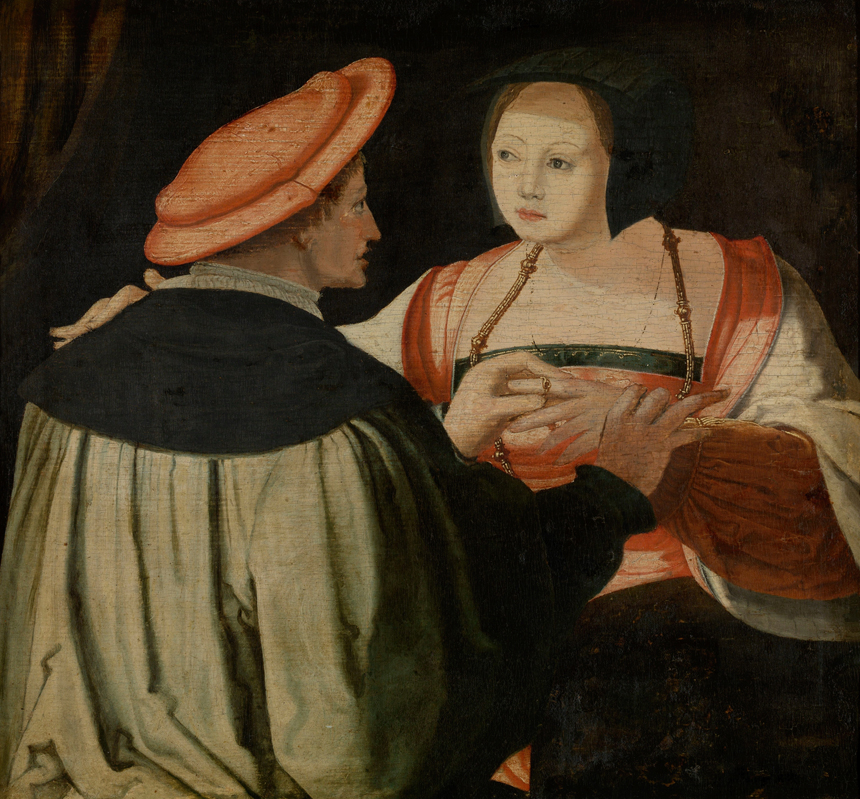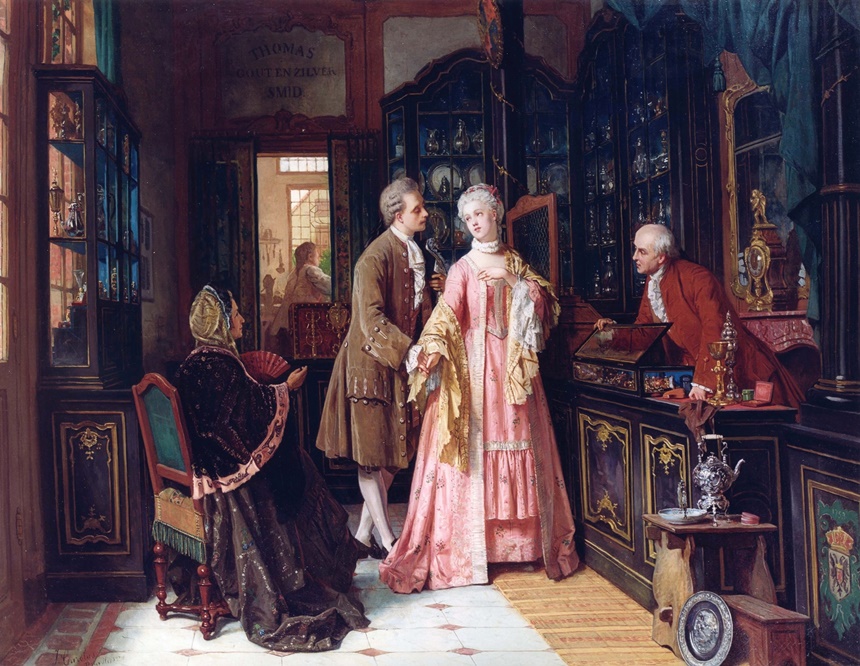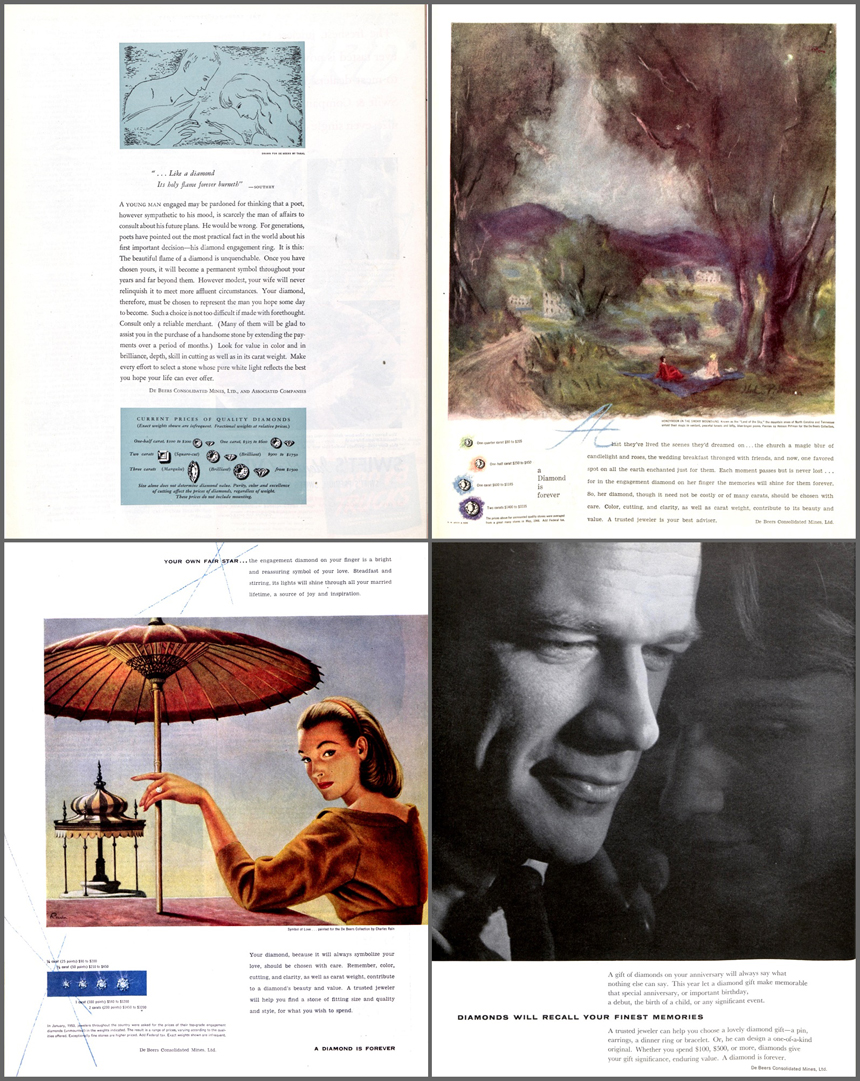Although there are many variables in a marriage proposal — the location, the surprise element, and of course the answer — one thing remains constant: it will almost always include a ring, and more precisely, a diamond ring.
While engagement or wedding rings are certainly not a new idea (after all, that custom goes back to the days of Ancient Rome), the prevalence of diamonds is a more recent phenomenon.

Diamond jewelry has been around since the thirteenth century, when royalty used the rare mineral to symbolize their power and status. These were incorporated into crowns, necklaces, and other jewelry, but they typically weren’t used to indicate someone’s love and commitment.

Mary of Burgundy was probably the first woman to ever receive a diamond ring as a love token upon her engagement to the Archduke Maximilian of Austria in 1477. Her ring, which was made of gold with diamonds that form the letter M, began a trend for the next century, when royals and other nobility chose to show their fidelity with these stones.
Yet, well into the 20th century, diamond rings were still uncommon when it came to marriage proposals. The custom of engagement rings came to the U.S. around the 1840s, but it was only in the 1870s, after the discovery of large diamond veins in South Africa, that diamonds became more available, even to the middle classes.
In 1888, in order to curb supply and control prices in the market, South African miners formed the De Beers Consolidated Mines Ltd. (now De Beers) cartel to protect their investment and profits. De Beers controlled every aspect of the industry — including marketing — investing great effort in convincing the masses that diamonds were rare and a symbol of status. But it would take another half century to make people associate them with love and marriage. Before World War I, most brides appreciated gemstones in their rings, but only 10 percent of these were diamonds.

With the onset of the Great Depression in the 1930s, the diamond trade went into a crisis. The price of diamonds fell globally, as people cut back on luxury and stuck to the basics. Marriage rates also fell, and the couples who did get engaged chose to express their commitment in cheaper rings with small and low-quality diamonds.
With a stockpile to sell, De Beers set on a mission to convince the world of the necessity of diamonds. In 1938, they hired the New York-based ad agency N. W. Ayer, who began a long, concerted campaign to equate diamonds with marriage and commitment.

Using Hollywood celebrities who showcased their diamonds on and off the screen, the campaign sought not to promote a specific brand, but to sell the idea that diamonds, and only diamonds, should be the measure of a man’s love: the bigger and more expensive the rock, the bigger a man’s commitment and the value of the marriage was.
In 1948, Ayer came up with one of the best ad slogans in history: “A Diamond Is Forever.” Now, not only were diamonds essential to marriage — a symbol of eternal love — but they also increased in value over time as few attempted to resell them. De Beers also set a monetary value for love, defining the standard investment of one month’s salary (by the 1980s it was two months) as the price to pay for something that would last forever.
And as diamonds became the standard of both men’s and marriage’s worth, women began to expect to receive them, and more importantly, to see them as a valued property. In an age when women did not have access to economic independence or power, their diamond rings became one of the sole sources of wealth and insurance for rainy days. Like Marilyn Monroe sang in the 1953 film Gentlemen Prefer Blondes (in another calculated commercial effort by Ayer): “Diamonds are a girl’s best friend.”
Marilyn Monroe singing “Diamonds Are a Girl’s Best Friend” in Gentlemen Prefer Blondes (Uploaded to YouTube by Marilyn Monroe Video Archives)
The strong association of diamonds with a (heterosexual) marriage commitment made De Beers profitable, but it was less successful when it tried to tap into new markets. In the 1980s, inspired by the rise of feminism and women’s growing economic independence, De Beers tried to persuade women to also give their spouses diamond rings. However, the campaign failed miserably, since no one was willing to let go the idea that a man’s love (and worth) — not a woman’s — was to be measured by carats.
To be sure, men also like to wear diamonds. In recent years, hip hop culture has celebrated all forms of bling, diamond jewelry included. And with the growing visibility of LGBTQ people, the sight of men in jewels has also become more mainstream. However, when it comes to engagement and wedding rings, women still hold a monopoly on diamonds. According to the marriage website The Knot, only 7 percent of men wear engagement rings (the majority of them belong to same-sex couples), and very few of them include gemstones.
Indeed, the association of diamonds with marriage is so powerful that it is not clear how De Beers will survive the steady decline in marriage rates. As the industry is once again in crisis, one attempt is to expand the notion of love beyond marriage. As a recent Jared commercial suggests, diamonds are for all significant others: mothers, sisters, even BFFs.
Love as we know can come in many forms, and marriage is only one of them. But square-cut or pear-shaped, as long as De Beers has a say in it, it will include diamonds — and lots of them.
Become a Saturday Evening Post member and enjoy unlimited access. Subscribe now



Comments
My daughter is currently studying Law at university and is very vocal about female equality.
However, when I showed her an article eschewing the practice of giving diamond engagement rings to brides in favour of something more practical, like putting the money towards a house deposit, she was aghast!
“If a man can’t afford to buy me a diamond engagement ring, he’s not the man for me!”
I was quite shocked. I told her diamonds are a false rarity and over-priced.
“ Because you believe in equality of the sexes, are you going to buy the man something expensive and frivolous … perhaps a Ferrari?”
That was over six months ago and we haven’t spoken since.
So I presume the answer was ‘no’.
Diamonds are not rare. Scarcity was created by deBears who have warehouses full of diamonds they are keeping off the market. When other rich deposits have been discovered, as in Arkansas they have made sure that the deposit was locked up in someway, and not available for commercial development
Thank you Bob, I’m glad you enjoyed the article. With declining marriage rates and the introduction of lab-grown diamonds the industry is indeed in crisis, but the most harm comes from their success of convincing the world that diamonds are forever.
Wonderful article Einav, on a topic I didn’t know I needed to learn more about, but glad I did. The historical research here very much appreciated, not to mention the art, ads, and probably Marilyn’s most famous film scene. I’m not sure what diamonds she had in real life, but Elizabeth Taylor was definitely the queen of diamonds, white or otherwise.
The Taylor-Burton diamond ring was so famous, that the season 3 opening episode of ‘Here’s Lucy’ featured the famous couple with Lucy (naturally) getting it stuck on her finger. I didn’t know the industry was in crisis mode, but not surprised. Pretty much everything is now, and likely to stay that way.